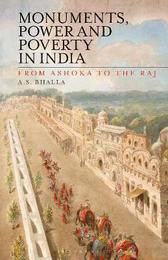
|
Monuments, Power and Poverty in India: From Ashoka to the Raj
Paperback / softback
Main Details
| Title |
Monuments, Power and Poverty in India: From Ashoka to the Raj
|
| Authors and Contributors |
By (author) Ajit S. Bhalla
|
| Physical Properties |
| Format:Paperback / softback | | Pages:264 | | Dimensions(mm): Height 216,Width 135 |
|
| Category/Genre | History of architecture
Asian and Middle Eastern history
Colonialism and imperialism |
|---|
| ISBN/Barcode |
9781350154698
|
| Classifications | Dewey:954 |
|---|
| Audience | | Tertiary Education (US: College) | |
|---|
| Illustrations |
51 bw illus, 10 colour in 8pp plates
|
|
Publishing Details |
| Publisher |
Bloomsbury Publishing PLC
|
| Imprint |
Bloomsbury Academic
|
| Publication Date |
19 March 2020 |
| Publication Country |
United Kingdom
|
Description
Much has been written about the Imperial architecture of the Indian subcontinent, but this is the first book to dig deeply into the extent of imperial extravagance set against the economic and social conditions of ordinary subjects. Bhalla uses an extensive collection of illustrations to complement this apparent paradox, assessing three Indian empires - Hindu, Muslim and British. From the 3rd century BC through to the end of British colonialism, splendid and often deliberately ostentatious buildings glorified the contemporary social structures. Moving through these different periods, important symbols of the various empires are assessed, including the fort palaces of Agra, Delhi and Lahore and the Taj Mahal. The author here examines both the positives and negatives of empire, taking in social stability but also exploitation and oppression, exploring the subject of Indian poverty in a historical perspective alongside the more lasting symbols of empire. Through comparisons and contrasts, from the mausolea and palaces of the Mughals to the government buildings and memorials provided by the British, this is a comprehensive and well-researched overview of a country whose architectural history gives important insights into the diversity of its rulers. This unique look into colonial architecture and power dynamics will prove essential readers for students, researchers and all those with an interest in South Asian history or the history of architecture.
Author Biography
A.S. Bhalla is a Special Professor at the School of Contemporary Chinese Studies, University of Nottingham, UK and was formerly Fellow of Sidney Sussex College, Cambridge and Special Adviser to the President of International Development Research Centre (IDRC), Ottawa. Earlier he had a distinguished career in the United Nations Civil Service. He has held academic positions at Cambridge, Oxford, Yale and Manchester. He is the author of Poverty and Exclusion of Minorities in China and Indi a, Royal Tombs of India and Poverty among Immigrant Children in Europe, among other publications.
|